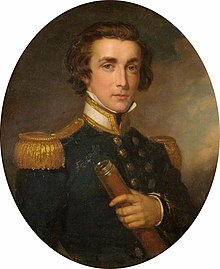William Peel (Royal Navy officer)
Sir William Peel | |
|---|---|
 | |
| Born | 2 November 1824 Mayfair, London, UK |
| Died | 27 April 1858 (aged 33) Cawnpore, British India |
| Buried | Old British Cemetery, Cawnpore, India |
| Allegiance | |
| Service/ | |
| Rank | Captain |
| Unit | Naval Brigade |
| Commands held | |
| Battles/wars | |
| Awards | |
| Relations | Sir Robert Peel (father) |
| Other work | Travel writer |

Captain Sir William Peel VC KCB (2 November 1824 – 27 April 1858) was a British naval officer and recipient of the Victoria Cross, the highest and most prestigious award for gallantry in the face of the enemy that can be awarded to British and Commonwealth forces. He was the third son of the Prime Minister Sir Robert Peel and his wife Julia. Like his father, he was educated at Harrow School.
He was made a Knight Commander of the Order of the Bath, and thus became Sir William Peel.
Military career[edit]
Peel was a captain in the Royal Navy, serving with the Naval Brigade during the Crimean War. On 18 October 1854 at the Siege of Sevastopol, he picked up a live shell with the fuse still burning from amongst several powder cases and threw it over the parapet. The shell burst as it left his hands.[1] For this he was awarded the Victoria Cross (VC); it is now displayed at the National Maritime Museum in Greenwich, England.
On 5 November at the Battle of Inkerman, he joined some of the officers of the Grenadier Guards and helped to defend the Colours of the regiment when they were hard-pressed. On 18 June 1855, he led the first scaling party at the assault on the redan and was himself severely wounded. On each of these occasions Captain Peel was accompanied by a young midshipman, Edward St. John Daniel, as Aide-de-camp.
After the Crimean War, he served in the Indian Mutiny and was wounded at the Relief of Lucknow. At the age of 33, he died of smallpox at Cawnpore, India, on 27 April 1858.[2]
Travel[edit]
Captain Peel wrote A Ride through the Nubian Desert (1852), detailing his travels of the preceding year.
Memorials[edit]

There is a memorial to Captain Peel and the Naval Brigade from HMS Shannon on the seafront at Southsea, England.[3]
There is a statue of William Peel by William Theed in the south transept of Saint Swithun's Church, Sandy, in Bedfordshire.[4] There are two copies of this statue, one in the National Maritime Museum in Greenwich [5] and one which was erected in Eden Gardens, Calcutta.[6] This statue was moved to Barrackpore in 1977 and was due to be moved back to Calcutta in 2004 amid some confusion over its identity: it was thought to be Peel's father, Robert Peel.[7]
Opposite Sandy church across the High Street stands the Sir William Peel pub.[8]
A plaque at The Lodge, headquarters of the RSPB in Sandy, commemorates the 150th anniversary of the death of Captain Sir William Peel. It is situated near the Swiss Cottage which he built in the 1850s, which is now the gatehouse to The Lodge, built by his brother Arthur Wellesley Peel.[9] A similar plaque is mounted on a bench on Sandy High Street.[10]
A statue of Peel by William Theed stands in the centre of Greenwich Maritime Museum.
See also[edit]
- O'Byrne, William Richard (1849). . . John Murray – via Wikisource.
References[edit]
- ^ "No. 21971". The London Gazette. 24 February 1857. pp. 651–652.
- ^ Victoria Cross (MED1252)
- ^ Memorial Details, "Memorials in Southsea - HMS Shannon -", Memorials and Monuments in Portsmouth Archived 20 January 2010 at the Wayback Machine
- ^ A Brief History of St Swithun's Church
- ^ "The statue of Sir William Peel (VC) | Captain Sir William Pe… | Flickr". 6 February 2010.
- ^ "Statue of Sir William Peel in the Eden Gardens [Calcutta]".
- ^ "The Telegraph - Calcutta : Metro". Archived from the original on 21 November 2004.
- ^ "Sir William Peel, Sandy, Bedfordshire | Orangeaurochs | Flickr". 31 March 2008.
- ^ "Plaque commemorating Captain Sir William Peel at the RSPB … | Flickr". 12 July 2009.
- ^ "Plaque commemorating Captain Sir William Peel on a bench o… | Flickr". 13 September 2011.
 This article incorporates text from a publication now in the public domain: "Peel, William". Dictionary of National Biography. London: Smith, Elder & Co. 1885–1900.
This article incorporates text from a publication now in the public domain: "Peel, William". Dictionary of National Biography. London: Smith, Elder & Co. 1885–1900.
- 1824 births
- 1858 deaths
- British military personnel killed in the Indian Rebellion of 1857
- British recipients of the Victoria Cross
- British travel writers
- Children of prime ministers of the United Kingdom
- Crimean War recipients of the Victoria Cross
- Deaths from smallpox in India
- Knights Commander of the Order of the Bath
- Officers of the Legion of Honour
- Peel family
- People from Mayfair
- People from Kanpur
- People educated at Harrow School
- Royal Navy officers
- Royal Navy personnel of the Crimean War
- Royal Navy recipients of the Victoria Cross
- Younger sons of baronets
- Royal Navy personnel of the Egyptian–Ottoman War (1839–1841)
- Royal Navy captains
